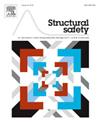Failure probability estimate of corroded reinforced concrete structures based on sparse representation of steel weight loss distributions
IF 6.3
1区 工程技术
Q1 ENGINEERING, CIVIL
引用次数: 0
Abstract
Uncertainties associated with the non-uniform spatial distribution of steel weight loss (SWL) should be considered appropriately when estimating the load-bearing capacity loss of corroded reinforced concrete (RC) structures. Addressing these uncertainties necessitates a probabilistic analysis using high-dimensional SWL data, which can lead to inaccurate condition assessments for corroded RC structures. This paper presents a dimension-reduction approach for SWL distribution based on the K-means singular vector decomposition (K-SVD) algorithm, which enforces a sparse representation of SWL distributions using a combination of non-standard distribution features learned from experimental SWL data. The K-SVD algorithm involves an iterative two-stage supervised learning process. In the dictionary learning stage, K-SVD identifies non-standard distribution features tailored to the localized characteristics of SWL data, based on which the orthogonal matching pursuit (OMP) algorithm is employed in the coding learning stage to derive a sparse representation of SWL distributions. The efficacy of K-SVD is evaluated using 83 experimental samples of SWL distributions. The results reveal that the K-SVD algorithm can derive a sparse representation of SWL distribution while preserving the distribution details of SWL. With just 15 learned non-standard distribution features, K-SVD achieves the same accuracy in reconstructing 168-dimensional SWL distribution data as the baseline Karhunen-Loève OMP (KL-OMP) method, which uses 75 standard features. Subsequently, the sparse representation is used to compute the flexural failure probability of corroded RC beams, for which a Kriging surrogate model is constructed. The results show that the sparse representation significantly enhances the accuracy of the Kriging surrogate model and improves the computational stability of the flexural failure probabilities, which is crucial for accurately assessing the condition of corroded RC structures.
基于钢筋减重分布稀疏表示的锈蚀钢筋混凝土结构失效概率估计
在对钢筋混凝土腐蚀结构的承载能力损失进行评估时,应适当考虑与钢筋重量损失(SWL)空间分布不均匀相关的不确定性。为了解决这些不确定性,需要使用高维SWL数据进行概率分析,这可能导致腐蚀RC结构的状态评估不准确。本文提出了一种基于k均值奇异向量分解(K-SVD)算法的SWL分布降维方法,该方法利用从实验SWL数据中学习到的非标准分布特征的组合来实现SWL分布的稀疏表示。K-SVD算法涉及一个迭代的两阶段监督学习过程。在字典学习阶段,K-SVD识别适合SWL数据局部特征的非标准分布特征,在此基础上,编码学习阶段采用正交匹配追踪(OMP)算法推导SWL分布的稀疏表示。使用83个SWL分布的实验样本对K-SVD的有效性进行了评估。结果表明,K-SVD算法在保留SWL分布细节的同时,可以得到SWL分布的稀疏表示。K-SVD只需要学习到15个非标准分布特征,就可以在重建168维SWL分布数据时达到与使用75个标准特征的基线karhunen - lo -OMP (KL-OMP)方法相同的精度。随后,利用稀疏表示计算腐蚀钢筋混凝土梁的弯曲破坏概率,并建立了Kriging代理模型。结果表明,稀疏表示显著提高了Kriging代理模型的精度,提高了抗弯破坏概率的计算稳定性,这对于准确评估腐蚀RC结构的状态至关重要。
本文章由计算机程序翻译,如有差异,请以英文原文为准。
求助全文
约1分钟内获得全文
求助全文
来源期刊

Structural Safety
工程技术-工程:土木
CiteScore
11.30
自引率
8.60%
发文量
67
审稿时长
53 days
期刊介绍:
Structural Safety is an international journal devoted to integrated risk assessment for a wide range of constructed facilities such as buildings, bridges, earth structures, offshore facilities, dams, lifelines and nuclear structural systems. Its purpose is to foster communication about risk and reliability among technical disciplines involved in design and construction, and to enhance the use of risk management in the constructed environment
 求助内容:
求助内容: 应助结果提醒方式:
应助结果提醒方式:


